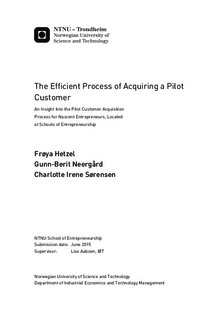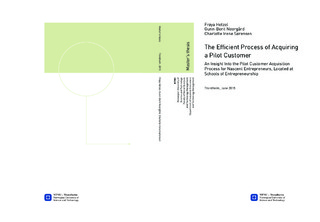| dc.description.abstract | The purpose of this thesis is to examine how nascent entrepreneurs, located in Schools of Entrepreneurship, pursue the process of initiating Business-to-Business relationships with pilot customers and how this process can be conducted efficiently. Acquiring a paying customer is the goal of many startups, and involving a pilot customer may be the first step in this process. This step is therefore of crucial importance for the startups (Jack, 2005), and is one of the greatest challenges (Aaboen, Dubois and Lind, 2011), due to the little research on the subject today (Aarikka-Stenroos and Halinen, 2007), the authors have decided to research the purpose as their master thesis.
Three research questions have been designed to fulfill the purpose. The first one examines how a nascent entrepreneur initiates Business-to-Business relationships with potential pilot customers. The second concerns the location of the nascent startup and examines how the connection to the School of Entrepreneurship affects the process of initiating relationships with pilot customers. The third and last research question examines the characteristics of an efficient process when acquiring a pilot customer. The literature study by Hetzel, Neergård and Sørensen (2014) provides the current theory with a new model to the process of acquiring a pilot customer. This thesis is partially based on that model, as the authors wish to examine if the theoretical model is representative for nascent startups located at Schools of Entrepreneurships.
This thesis has been carried out by two data collection methods, using the theoretical framework of Hetzel, Neergård and Sørensen s (2014). The second method consists of interviews. The content from the theoretical framework is partially derived from the project assignment in TIØ4530 Innovation and Entrepreneurship which was conducted during the autumn of 2014. Additional literature needed to answer the purpose has been acquired through searches in Web of Science . The interviews were conducted in the spring of 2015 at two Schools of Entrepreneurship in two different countries. The respondents had one of the following three roles in the School of Entrepreneurship, staff, mentor or nascent entrepreneur, which is a student at the School of Entrepreneurship. Respondents were chosen to gain a broad overview of the School of Entrepreneurship to fulfill the purpose.
The results of the analysis provides a foundation for an updated model on the process when acquiring a pilot customer, which is shown through the first research question. Through analysis on the second research question, the authors received results showing that the third actors are not actor-based, but rather actions-based. This is due to several third actors providing the nascent entrepreneurs with the same actions. The analysis shows that the main characteristics of an efficient process is using one s network and being highly assertive.
This leads to the discussion on relationship management, network overload, learning through iterations and third actors influencing the process. The discussion shows that relationship management consists of being active and building one s network continuously, handling network overload through strategic dormant phases, focusing on highly assertive tasks and acquiring pilot customers based on quality, rather than quantity. Learning through iterations showed that the nascent entrepreneurs must go through a learning process to find third actors who can actually be involved in the process and the mentoring function being the most important one. Actions are presented as far more important than the actors performing them and, the nascent entrepreneurs should focus on the actions, not actors.
The thesis provides several implication for the nascent entrepreneurs, the staff, the mentors and the pilot customers. The main implication lies in the nascent entrepreneurs receiving essential information on how to make the process towards a pilot customer efficient, with especially focus on network management and being highly assertive. The staff will receive information on improvements in the structure and management of the School of Entrepreneurship, such as creating a new process for the mentor allocation. The study does however show that there is still room for improvements in the theoretical area on the nascent startups located at Schools of Entrepreneurships, how third actors affect the process when acquiring a pilot customer and how a nascent entrepreneur can execute this process efficiently. The authors therefore recommend further research on efficiency to be based on a new model presented in this thesis. In this way one can validate if the new theoretical model on an efficient process is representative for the nascent startups located at a School of Entrepreneurship. | |

